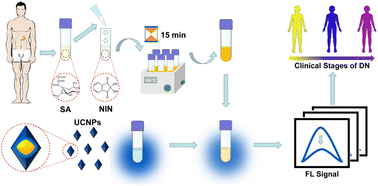Designing stimuli-responsive upconversion nanoparticles based on a mimetic immunoassay for potential accurate diabetic nephropathy diagnosis†
Abstract
Diabetic nephropathy (DN) is the most common microvascular complication associated with incurable diabetes. The gold standard diagnostic method for DN is based on the detection of proteinuria but it overlooks cases of non-proteinuria (NP-DN). To address this limitation, urinary sialic acid (SA) has been confirmed as an effective biomarker for various DNs. Herein, we constructed an ultrasensitive non-proteinuria assay platform to accurately diagnose DN within 20 min. This platform utilized the ninhydrin reaction between acidic ninhydrin and urinary sialic acid (SA) as an effective biomarker for various DNs. A compound with a maximum absorption peak at 470 nm was produced in this reaction and contributed to the fluorescence decrease of the blue-emission core–shell upconverting nanoparticles through the inner filter effect (IFE). By integrating the inner filter effect (IFE) with a mimetic immunoassay, the imperceptible color was converted into highly sensitive fluorescence signals. This protocol shows a stable and high sensitivity with a detection limit of 20 nmol L−1 and provides 100% positive prediction for urine samples, demonstrating its potential for clinical diagnosis and long-term monitoring of DN.



 Please wait while we load your content...
Please wait while we load your content...